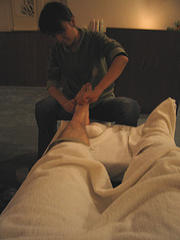|
Visiting a Reflexologist
Going to see a reflexologist? or considering it? Read on to learn what a session of reflexology therapy is like, and how to prepare for one in order to get the most health benefit. If you haven't read the introduction to reflexology, you may want to do so now. In a typical reflexology treatment, the therapist and patient would actually meet before the therapy itself. At this discussion, you'll cover your specific health concerns or issues. This helps the therapist to focus more accurately on how to treat you, right down to which pressure points will be getting the most attention. In response to our recent poll, I've included a video showing a reflexologist in action. Thanks for answering the poll! If you prefer reading more details, simply continue through the next three paragraphs. The Session Itself:45 minutes for the Sole; 15 minutes for the Palm (optional) You may expect about 45 minutes of actual foot-pressure. Most often, a reflexology session begins by focusing on the sole of the foot (see video). You'll be given the time to uncover your feet, removing shoes and socks. Then, you'll seat yourself comfortably in a chair that elevates the feet for the practitioner's best working angle. (And a lap blanket for additional comfort is usually provided!) The reflexologist will use his or her thumbs to rub and stimulate the sole of one foot, moving along the meridians according to your specific health issues. Later, the other sole will be worked on as well. Pressure is applied with the thumb and forefinger, often working toward your heel (or the outer palm, for the hand). You won't be able to see this, probably, so I'll tell you that they're using a bent thumb.... although some therapists also use simple tools, like a pencil eraser. If you choose, you can add an additional 15 minutes for the palm of your hand. This entire procedure is done skin-on-skin. Unlike massage, no oils or lotions are used, although in the video below, Ronald Leibel does apply a cream to the foot. (That was a surprise to the Health Hound, but that's what the Reflexology Association of America recommends.) Your foot actually is home to 7,000 nerve endings, so it's a rich location for pain relief and other health benefits. As promised: a Video!Here, reflexologist and instructor Ronald Leibel demonstrates here an advanced technique "sliding thumb". The videography is a bit jumpy, but easy to see what he's doing, and how a patient is set up for comfort. Run time: 3 minutes. Getting the Most out Your SessionBe sure you talk openly about any health issues at the pre-treatment meeting. On the day you go, drink plenty of water beforehand... ...as you would before a massage. This promotes the best circulation within the body (and most of us don't get enough water daily) so that things like lactic acid that are loosened by the treatment, can leave your body without undue discomfort. Let your feet and hands be free of moisturizers. No other preparation is needed. Enjoy! How Long until I Feel Better?If proper technique and pressure are used, treatment will do no harm, and there are very few cases when reflexology treatment is not appropriate. Following treatment, you may have a ‘healing reaction’, such as a streaming nose (if you came in for sinus congestion) or increased bowel and bladder activity. These reactions will only be short term and will occur only after the first few treatments. After treatment, you may feel tired, although some people are energized. Another example of the uniqueness of our bodies! You'll probably sleep that night, too. Weekly sessions, for three to six weeks is usually required. You may expect to see some improvement after three treatments, whether it is small or great. Some patients find great relief after the six weekly sessions, and decide to return at intervals for maintenance...perhaps every four, five or six weeks to maintain their health benefits and prevent other problems from arising. Two Cautions: Do NOT have reflexology is you are pregnant! Although Mayo Clinic found it is effective in reducing the pain of childbirth, it can actually bring on labor prematurely.
I think that about covers the visit to a reflexologist. I hope you've enjoyed the information as much as I enjoyed doing the research. Now, the Health Hound is off on another trail to track down alternative health options for your optimum health! To jump from Reflexologist Visit to Bodywork hub page. To the Health Hound's home page.
|





